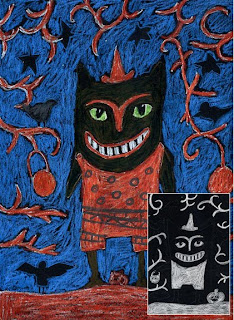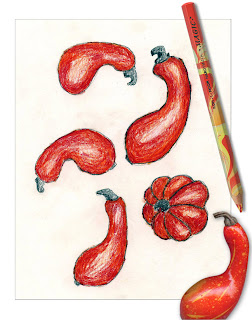 Day of the Dead is a holiday celebrated in Mexico and Latin American on Nov. 1st and 2nd. The holiday focuses on gatherings of family and friends to remember friends and family members who have passed on. I like how the festivities include lots creative imagery with patterns. This project was inspired by a Day of the Dead postcard which featured a very patterned skull drawing.
Day of the Dead is a holiday celebrated in Mexico and Latin American on Nov. 1st and 2nd. The holiday focuses on gatherings of family and friends to remember friends and family members who have passed on. I like how the festivities include lots creative imagery with patterns. This project was inspired by a Day of the Dead postcard which featured a very patterned skull drawing.1. In order to get the students drawing their patterns as soon as possible, I made cardboard templates of skulls for them to trace with a pencil on a black piece of paper. I reminded them that when they drew their eyes, they should be in the middle of the head, sitting on a imaginary line across the center, not up in the forehead. The triangle nose is halfway down, and the mouth halfway down again. I find you can’t remind students often enough about these feature placements. There is just some natural tendency for some to draw their eyes up in the top half of the heads.
2. Once the features were in their correct place, I gave each student a silver Sharpie marker and had them trace their lines. They could then draw in whatever patterns they wanted, I just stipulated that all shapes must be balanced to make the drawing symmetrical. If they drew a flower on a left cheek, they had to draw the same flower on the right. I think this is a good introduction to symmetry for those as young as first grade. Older students can get the idea reinforced,
3. The students were instructed to fill the face with as many symmetrical shapes as possible. When spaces got smaller, they could make lots of circles, and when the spaces were smaller still, they could fill them in with dots.
CA Visual Arts Standard: Grade Four
2.2 Use the conventions of facial and figure proportions in a . . . study.
 Last week I received this wonderful photo from a 4th grade class in Royalton, Minnesota. Their teacher, Erin, had tried out my Picasso Paper Bag Costume project with her entire class and agreed to share her results. Are these a bunch of cute and creative kids or what? I love all the colorful faces and the animated posing too, it really makes for a wonderful photo. Thanks kids, for letting me share your art with my readers.
Last week I received this wonderful photo from a 4th grade class in Royalton, Minnesota. Their teacher, Erin, had tried out my Picasso Paper Bag Costume project with her entire class and agreed to share her results. Are these a bunch of cute and creative kids or what? I love all the colorful faces and the animated posing too, it really makes for a wonderful photo. Thanks kids, for letting me share your art with my readers. 

 9:23 PM
9:23 PM
 keprok
keprok






























